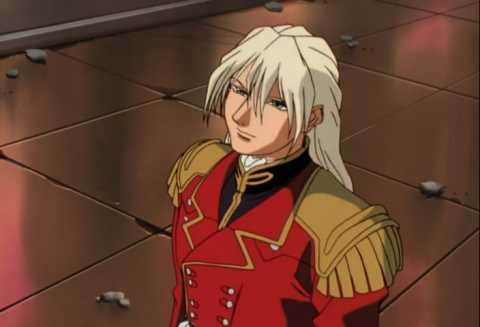Within the Mobile Suit Gundam Wing universe—where ideals clash as fiercely as Mobile Suits—one character stands out with elegance, complexity, and magnetic presence: Zechs Merquise. The man behind the silver mask is no mere soldier; he is a symbol of the eternal conflict between vengeance and peace, between identity and duty. This article dives into the soul behind the helmet, exploring his evolution and his lasting legacy in the Gundam universe.

The Prince Who Became Lightning
Before he was Zechs, he was Milliardo Peacecraft, heir to a kingdom devoted to absolute pacifism. But the destruction of his homeland and the murder of his royal family drove him to abandon his name and assume a new identity. As Zechs Merquise, he becomes one of the top soldiers in OZ, a military organization that stands for everything his childhood home opposed.
This duality—a pacifist prince turned warrior—is the foundation of his character. He doesn’t seek power out of ambition, but justice disguised as destruction. Contradiction is his core.
Deadly Elegance: The Knight of the Battlefield
Zechs is not a typical antagonist; he is a refined, disciplined, and brilliant tactician. Known as the “Lightning Count”, his combat skills are legendary. But more than just a soldier, he is a thinker with a purpose. Every battle he fights is not just physical—it’s moral.
From his first encounters with Heero Yuy, it's clear that both fight for more than victory: they fight for competing definitions of justice. Zechs believes justice requires tearing down the system before peace can begin, even if what should replace it remains unclear.
Steel Mask, Torn Soul
Zechs' silver mask is more than a visual accessory or a means to conceal his identity—it’s a statement. It allows him to distance his actions as a soldier from his past as a pacifist noble. The deeper he sinks into war, the more he depends on that emotional shield.
When he finally removes it, it’s not just for show. It marks a rebirth. It means he’s done hiding, ready to face his ideals and contradictions as Milliardo, not as Zechs.
Shadows and Light: His Conflict with Relena
His relationship with Relena Peacecraft, his younger sister, is one of the narrative’s most emotionally powerful threads. While she inherits their family's ideals and fights for peace without weapons, he embodies the opposite: the belief that peace is impossible without first destroying the corrupt systems that sustain war.
More than siblings, they are two sides of the same coin. And though their paths often diverge, their emotional bond never breaks. Zechs cannot ignore Relena because she reminds him of who he was—and who he might still be.
Between Machines and Demons: Zechs' Mobile Suits
Zechs is closely tied to two of Gundam Wing’s most iconic Mobile Suits:
- The Tallgeese: a beast of a machine, fast and deadly, nearly uncontrollable. Piloting it is almost suicidal, symbolizing Zechs’ resolve—and his disregard for his own life.
- The Gundam Epyon: more than just a suit, it’s a mirror of his soul. With no automated systems, it requires full mental connection with the pilot. Its demonic design and fiery saber reflect Zechs’ moral ambiguity—justice, yes, but soaked in blood.
These machines mark key phases in his journey and embody his inner transformation.
From Warrior to Rebel: The Rise of Commander White Fang
When Zechs discards his alias and reclaims his name—Milliardo Peacecraft—he becomes the leader of White Fang, a revolutionary group of space colonists. Here, he fully transforms into an agent of controlled chaos. He no longer seeks reform; he wants to reset the entire world.
He declares total war on Earth to “free” it from its endless conflict cycle. At this point, he becomes almost messianic to some, and terrifying to others. Ironically, in trying to end war, he ends up waging the largest one of all.
His final showdown with Heero is no longer just about piloting; it’s philosophical: Can a better world rise from destruction? Or is peace something built slowly—with open hands, not closed fists?
Mirror of Shadows: Zechs as Reflection of Heero and Char
Zechs is many things—but never simple. He is often compared to Char Aznable, the legendary rival of Amuro Ray. Like Char, Zechs is a masked noble driven by trauma and loss, who eventually leads a space-based rebellion. Yet he’s not a mere copy: where Char is cynical and calculating, Zechs is introspective and emotional.
He also mirrors Heero Yuy—not as an enemy, but as a philosophical counterweight. Heero learns to live; Zechs often dances with death, as if it were the cost of his ideals. Both want to change the world, but their methods differ radically.
Quiet Redemption: Zechs' Final Echo
In the movie Endless Waltz, Zechs returns as a calmer, more composed figure. No longer needing masks or grand declarations, he simply exists—watching, waiting, ready to intervene if needed.
He has found internal peace, even if the world hasn’t. He no longer seeks to destroy it. He trusts that there may be hope, thanks in part to those like Heero and Relena who continue to walk the narrow path of peace.
Zechs Merquise is not a villain, nor a classic hero. He is a soul perpetually torn—between sword and speech, between mask and true face. His story reminds us that the road to peace is rarely clean, often paved with contradiction, loss, and moral complexity.
What makes him unforgettable isn’t just his piloting prowess or iconic appearance—but his humanity. Zechs embodies the inner struggle we all face when our ideals clash with reality. That’s why, even years after Gundam Wing ended, he remains one of the most compelling figures in the entire Gundam legacy.


